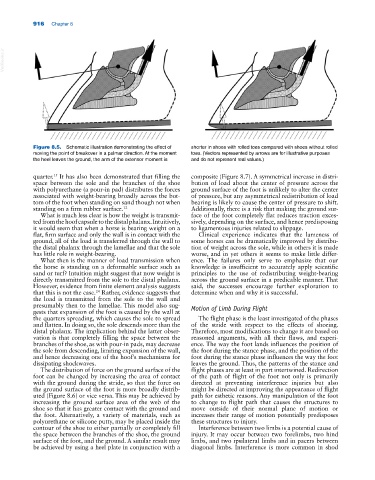Page 950 - Adams and Stashak's Lameness in Horses, 7th Edition
P. 950
916 Chapter 8
VetBooks.ir
Figure 8.5. Schematic illustration demonstrating the effect of shorter in shoes with rolled toes compared with shoes without rolled
moving the point of breakover in a palmar direction. At the moment toes. (Vectors represented by arrows are for illustrative purposes
the heel leaves the ground, the arm of the extensor moment is and do not represent real values.)
15
quarter. It has also been demonstrated that filling the composite (Figure 8.7). A symmetrical increase in distri-
space between the sole and the branches of the shoe bution of load about the center of pressure across the
with polyurethane (a pour‐in pad) distributes the forces ground surface of the foot is unlikely to alter the center
associated with weight‐bearing broadly across the bot- of pressure, but any asymmetrical redistribution of load
tom of the foot when standing on sand though not when bearing is likely to cause the center of pressure to shift.
standing on a firm rubber surface. 12 Additionally, there is a risk that making the ground sur-
What is much less clear is how the weight is transmit- face of the foot completely flat reduces traction exces-
ted from the hoof capsule to the distal phalanx. Intuitively, sively, depending on the surface, and hence predisposing
it would seem that when a horse is bearing weight on a to ligamentous injuries related to slippage.
flat, firm surface and only the wall is in contact with the Clinical experience indicates that the lameness of
ground, all of the load is transferred through the wall to some horses can be dramatically improved by distribu-
the distal phalanx through the lamellae and that the sole tion of weight across the sole, while in others it is made
has little role in weight‐bearing. worse, and in yet others it seems to make little differ-
What then is the manner of load transmission when ence. The failures only serve to emphasize that our
the horse is standing on a deformable surface such as knowledge is insufficient to accurately apply scientific
sand or turf? Intuition might suggest that now weight is principles to the use of redistributing weight‐bearing
directly transmitted from the sole to the distal phalanx. across the ground surface in a predicable manner. That
However, evidence from finite element analysis suggests said, the successes encourage further exploration to
24
that this is not the case. Rather, evidence suggests that determine when and why it is successful.
the load is transmitted from the sole to the wall and
presumably then to the lamellae. This model also sug- Motion of Limb During Flight
gests that expansion of the foot is caused by the wall at
the quarters spreading, which causes the sole to spread The flight phase is the least investigated of the phases
and flatten. In doing so, the sole descends more than the of the stride with respect to the effects of shoeing.
distal phalanx. The implication behind the latter obser- Therefore, most modifications to change it are based on
vation is that completely filling the space between the reasoned arguments, with all their flaws, and experi-
branches of the shoe, as with pour‐in pads, may decrease ence. The way the foot lands influences the position of
the sole from descending, limiting expansion of the wall, the foot during the stance phase, and the position of the
and hence decreasing one of the hoof’s mechanisms for foot during the stance phase influences the way the foot
dissipating shockwaves. leaves the ground. Thus, the patterns of the stance and
The distribution of force on the ground surface of the flight phases are at least in part intertwined. Redirection
foot can be changed by increasing the area of contact of the path of flight of the foot not only is primarily
with the ground during the stride, so that the force on directed at preventing interference injuries but also
the ground surface of the foot is more broadly distrib- might be directed at improving the appearance of flight
uted (Figure 8.6) or vice versa. This may be achieved by path for esthetic reasons. Any manipulation of the foot
increasing the ground surface area of the web of the to change to flight path that causes the structures to
shoe so that it has greater contact with the ground and move outside of their normal plane of motion or
the foot. Alternatively, a variety of materials, such as increases their range of motion potentially predisposes
polyurethane or silicone putty, may be placed inside the these structures to injury.
contour of the shoe to either partially or completely fill Interference between two limbs is a potential cause of
the space between the branches of the shoe, the ground injury. It may occur between two forelimbs, two hind
surface of the foot, and the ground. A similar result may limbs, and two ipsilateral limbs and in pacers between
be achieved by using a heel plate in conjunction with a diagonal limbs. Interference is more common in shod

